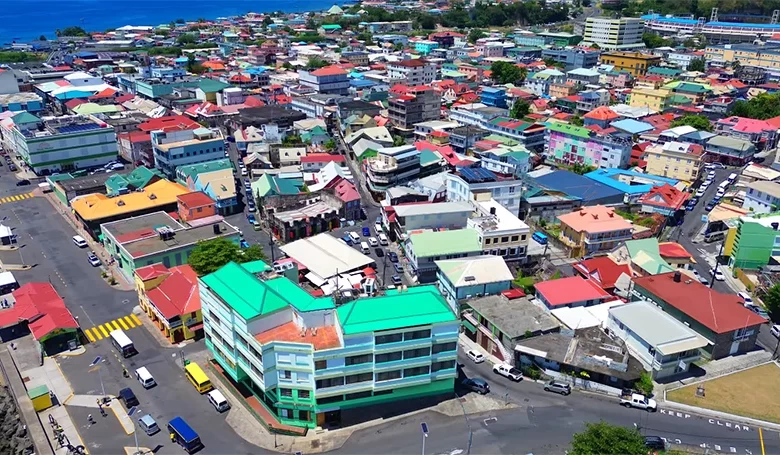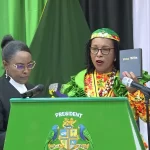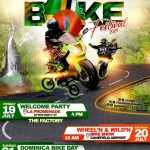Commonwealth of Dominica

Commonwealth of Dominica is an island nation in the Eastern Caribbean, frequently celebrated for its remarkably preserved ecosystems, rich Creole culture, and dedication to sustainability. Also called the Nature Isle of the Caribbean, it has distinguished itself from nearby territories through expansive rainforests, volcanic peaks, and pristine rivers. Although its land area spans roughly 750 square kilometers, Dominica’s intricate landscape supports an extensive range of flora and fauna unique to the region. Over the centuries, the island has survived European colonization, struggled with shifting economic models, and confronted the threats of natural disasters—yet it has consistently drawn strength from community bonds and adaptive governance. Explore the island’s physical features, history, political structures, economy, cultural identity, tourism sectors, environmental stewardship, and current trajectory in global affairs.
Physical Geography and Dominica’s Tropical Climate
Dominica’s terrain is famously rugged and dramatic, a product of its volcanic origins. Steep mountain ranges crisscross the interior, many cloaked in primary rainforest. Peaks such as Morne Diablotin and Morne Trois Pitons dominate the skyline, often swathed in clouds and influencing an abundance of rain-bearing winds. Dominica enjoys a tropical climate characterized by high humidity and year-round warm temperatures. However, microclimates can be found throughout the island due to abrupt changes in elevation and orientation to prevailing trade winds.
Rivers figure prominently in Dominica’s volcanic landscape. The abundance of waterways has spurred the widely circulated claim that the island boasts “365 rivers, one for each day of the year.” While not precisely verified, this reference highlights how water resources shape daily life and biodiversity. Many natural hot springs exhibit geothermal activity, especially within areas in the Roseau Valley like Wotten Waven and Laudat. The Valley of Desolation, with its Boiling Lake, further emphasises its volcanic heritage. These features also supply the island with natural sulphur springs, popular among residents and visitors for their therapeutic properties.
Dominica’s Coastline extends around mountainous contours, providing varied seascapes that shift from calm coves on the Caribbean Sea on the west coast to more forceful Atlantic Ocean action along the east coast. While western shores harbour tranquil waters and are conducive to trade and tourism, the eastern side faces stronger ocean currents. Dominica’s calm leeward waters also support recreational boating—although the island is still developing compared to more established yachting centres in the region.
Owing to heavy rainfall, warm temperatures, and fertile volcanic soils, Dominica boasts some of the lushest flora in the Caribbean. The mountainous interior nourishes towering hardwoods like Chatannyé trees and Gommier and endemic orchids and ferns. Because the environment remains relatively undisturbed, modern scientists frequently study its rainforests for insights into Caribbean ecosystems. Meanwhile, slopes of Dominica’s Northeast hold vital farmland where bananas and dasheen remain among the most important crops.
Historical Overview and Evolution of Governance
Before European intrusion, the Kalinago (also called Caribs) inhabited Dominica for centuries, maintaining a rich cultural legacy that persists in the Carib/Kalinago Territory. Known for a storied heritage of craftsmanship and seafaring, the Kalinago people first faced large-scale upheaval with the advent of Spanish, French, and British colonization. Although Christopher Columbus did not Discover Dominica—Indigenous peoples had long settled on the island—his arrival in 1493 marked the beginning of extensive European involvement in the region.
France and Britain vied for control of Dominica, reflecting broader colonial rivalries. The island eventually became a British possession, which introduced plantation economies reliant on slave labour. Over time, enslaved Africans contributed labour and cultural elements to the emerging Creole society. Following the abolition of slavery in the 19th century, agricultural enterprises evolved around small-scale holdings, especially where former plantations were sold or abandoned.
When the era of decolonization took hold worldwide, Dominica moved toward self-governance. The island adopted new constitutional frameworks and, under the Constitution of Dominica, transitioned from a British colony to a fully independent state on November 3, 1978. Celebrations of Dominica’s Independence continue annually and exhibit hallmark cultural traditions such as the Wòb Dwiyèt (a traditional Creole dress), folk dances, and the performance of the Dominica’s National Anthem. Today, Dominica remains a parliamentary democracy within the Commonwealth, honouring the British monarch as a symbolic head but forging its path politically and socially.
Political and Administrative Structure
Governance in the Commonwealth of Dominica adheres to a Westminster-style model. The island’s political framework merges elements of parliamentary custom with local administrative councils in villages such as Penville Village Council or Giraudel/Eggleston Village Council. At the national level, the legislative branch comprises an elected House of Assembly. Executive power rests with the Prime Minister and Cabinet, while the President, chosen by the House of Assembly, serves as ceremonial Head of State.
The island is divided into ten administrative parishes—like Saint Andrew Parish, Saint David Parish, and others—mirroring a historical arrangement dating back to colonial times. Village Councils coordinate infrastructure upkeep, community events, and local social services, often collaborating with relevant ministries. While challenges persist—such as ensuring consistent roads, modern healthcare facilities, and reliable utilities—many communities exemplify resilience, aided by civic leaders and grassroots organizations.
Relations with international allies and organizations, including the Organization of American States (OAS) and Caribbean Development Bank, complement the work of various NGOs. Efforts by the Dominica Community Tourism Association, Dominica Amateur Athletic Association (DAAA), and others help strengthen social cohesion. Economic priorities often align with environmental stewardship, reflecting the island’s aspiration to lead as the World’s First Climate-Resilient Nation.
Economy and Agriculture
Though historically anchored in sugar, cocoa, and coffee under the plantation system, Dominica’s economy shifted emphasis to bananas in the 20th century. Today, agriculture remains a crucial employer in many rural parishes. Crops like plantains, citrus fruits, root crops, and tropical spices contribute to local consumption and export. Initiatives championed under the Dominica Banana Marketing Corporation (DBMC) and related bodies aim to keep the agricultural sector competitive amidst shifting global trade policies.
Beyond agriculture, the service sector—especially tourism—has experienced considerable growth. Dominica’s vantage as the Nature Island of the Caribbean offers a competitive niche, as ecologically conscious travelers opt for unspoiled destinations over high-density resorts. Meanwhile, small manufacturing – under groups like the Dominica Manufacturer’s Association (DMA) – produces soaps, essential oils, and artisanal crafts with export potential. The island also benefits from offshore services, although these remain modest compared to other Caribbean offshore centres.
In rural communities, credit unions and cooperative banks facilitate financial inclusion. Entities such as the Marigot Co-operative Credit Union Ltd. (MCCU) and Grand Bay Co-operative Credit Union Ltd. demonstrate how local-level financial institutions can spur entrepreneurship. Government-led projects emphasizing food security, youth employment, and agricultural modernization, like the Emergency Agricultural Livelihoods & Climate Resilience Project, further complement grassroots endeavours, striving to ensure that the gains from tourism and production do not come at the expense of local well-being.
Cultural Identity and Heritage
Dominica’s cultural identity weaves African, European, and Indigenous Kalinago elements, resulting in unique Creole traditions. This mosaic finds expression in art, music, dance, fashion, cuisine, and linguistic forms. Events like Creole Day in Dominica, Dominica’s Independence celebrations, and the annual Cultural Gala highlight local styles of dress (like the Wòb Dwiyèt), a Creole dialect brimming with French-based vocabulary, and the distinct rhythms of Jing Ping band music.
The island’s motto, Après Bondie C’est La Ter (French Creole for “After God Is the Earth”), encapsulates local reverence for spirituality and the environment. This connection is reinforced by widespread religious observances, from Catholic feast days to Protestant services and Rastafarian gatherings, reflecting the multiplicity of beliefs among Dominicans. Dominica’s National Anthem resonates during national ceremonies, often performed in English and Creole contexts.
Folk traditions also persist through storytelling, known in the local patois as kont, and various dance forms such as Bèlè, Quadrille, and Lancers, which link modern performances to historical roots. Carnival season is a festive period featuring costume parades, calypso performances, and other public events that unify the island in creative revelry.
Environmental Stewardship and Protected Areas
Efforts to protect Dominica’s ecological wealth date back to the National Parks and Protected Areas Act, 1975, which set the foundation for numerous conservation projects. The island features Dominica’s National Parks, including Morne Trois Pitons National Park, designated a UNESCO World Heritage Site in 1997. These protected regions incorporate volcanic landscapes, pristine waterfalls, and a broad array of endemic species.
Dominica’s identity as the Nature Isle of the Caribbean fosters its approach to sustainable development. Dominica’s Eco-Tourism sector highlights birdwatching, canyoning, river tubing, and hiking across the Waitukubuli National Trail (WNT)—the Caribbean’s longest hiking trail, spanning over 180 kilometers in fourteen segments (#1, #2, #3, #4, #5, #6, #7, #8, #9, #10, #11, #12, #13 and #14). Hikers experience panoramic mountain vistas, waterfalls like Trafalgar Falls and Sari-Sari Falls, and the biodiversity of mountainous rainforests.
Marine conservation also takes center stage. The island’s seas harbor healthy coral reefs and support whales, dolphins, and a variety of fish species. Partnerships with the Dominica Coast Guard and local dive shops safeguard these resources. Meanwhile, organizations like the Dominica Community Tourism Association and Dominica Hotel & Tourism Association (DHTA) develop guidelines that limit environmental impact in scuba diving, yachting, or coastal resort development.
Equally noteworthy is Dominica’s campaign toward climate resilience. The government launched large-scale housing projects and infrastructural upgrades after devastating hurricanes, exemplified by the quest to become the World’s First Climate-Resilient Nation. These initiatives prioritize renewable energy (especially geothermal), robust building codes, and ecosystem management to buffer the effects of strong winds, storm surges, and potential flooding in low-lying communities.
Tourism, Cruise Industry, and Cultural Experiences
While Dominica welcomes visitors through the cruise industry, it preserves a reputation distinct from more commercialized Caribbean ports. Emphasis often lies on immersive cultural interactions and eco-adventures over mass-market beach tourism. Passengers may disembark in the capital, Roseau, to browse the produce-laden Roseau Market, partake in Creole culinary tours, or sign up for guided hikes into the interior.
Extended-stay visitors can explore marine attractions like Champagne Reef—where geothermal vents release bubbles along the ocean floor—or delve into the wonders of the Soufriere Scotts Head Marine Reserve. Whale-watching tours, especially for sperm whales that make it home year-round, have gained global acclaim. Inland hot springs beckon travelers to rejuvenate after a day of hiking or canyoning. Festivals like the World Creole Music Festival gather local and international artists, celebrating Dominica’s standing as a cradle of Creole rhythms.
Community-driven tourism thrives in villages like the Kalinago Territory, where local guides share insights on basket weaving, canoe construction, and herbal medicine. Additional cultural experiences might feature homestays, cooking demonstrations, and storytelling. Organizations like Dominica Tourism Concierge and other providers aim to curate respectful, enriching tours highlighting the island’s natural and cultural uniqueness.
Modern Challenges and Ongoing Prospects
Dominica continually grapples with developmental constraints, including limited airlift, vulnerability to hurricanes, and a relatively small consumer base. Hurricanes such as David (1979) and Maria (2017) inflicted catastrophic damage, underscoring climate change’s intensifying threat to small island states. Despite these challenges, Dominica has embraced forward-thinking policies, often collaborating with development agencies, philanthropic foundations, and diaspora communities.
Technological expansion—through improved internet coverage and digital platforms—enables entrepreneurs to promote local crafts, coordinate eco-tours, and reach global markets for niche agricultural products like cocoa sticks, coffee, or essential oils. At the policy level, the island leverages global frameworks to fund climate adaptation projects. Initiatives focus on reforestation, riverbank stabilization, green housing solutions, and microgrid expansions to bolster energy independence.
Non-governmental organizations and international partnerships also play a role. Groups like the Dominica National Conservation Trust Fund (DNCTF) distribute resources for biodiversity initiatives. At the same time, specialized training from entities such as the Dominica Amateur Athletic Association (DAAA) fosters youth development in sports. Government-sponsored scholarship programs encourage students to pursue higher education abroad, adding professional expertise to the local human capital.
Cultural Symbols and National Identity
Dominica’s sense of nationhood remains firmly grounded in tradition and communal pride. The National Flag of Dominica features a Sisserou Parrot (Amazona imperialis), recognized as Dominica’s National Bird under the National Emblems Act of 1978. Known as the Sisserou Parrot, it symbolizes the island’s ecological wealth. Many regard the parrot’s endangered species status as indicative of environmental fragility, spurring conservation efforts. Another symbolic representation is the national motto: Après Bondie C’est La Ter, reflecting spirituality and an enduring reliance on the land.
National weeks such as National Emblems Week or Heritage Day highlight music, dance, storytelling, and culinary showcases across primary schools and village centres. Young Dominicans learn the significance of the Wòb Dwiyèt, an attire used during Creole Day in Dominica and independence celebrations. Distinct language traditions, including Haitian Creole influences on local patois, connect Dominicans to the broader Creole-speaking world in the Caribbean.
These symbols weave a cultural narrative that permeates government addresses, tourism promotions, and everyday social interactions. They also reinforce the notion that Dominicans share a distinct heritage separate from the more homogenized tourist circuits of the region.
Integrating Tradition and Progress
Balancing modernization with preserving intangible cultural assets continues to guide Dominica’s trajectory. While economic reforms target industry growth, decision-makers remain sensitive to calls for ecological responsibility. For instance, infrastructure projects typically undergo environmental assessments, striving to harmonize new construction with Dominica’s Natural Beauty, which draws visitors. The synergy of local governance, private enterprise, and community activism underlines the island’s holistic approach to growth.
In sports, collaborations with bodies like the Dominica Athletic Association (DAA) or Dominica Football Association open avenues for youth engagement, forging vibrant community involvement. Meanwhile, the presence of diaspora members who regularly return for events—such as the Independence Day festivities or carnival—reinforces intergenerational continuity.
Educational strides also demonstrate how tradition and progress converge. Primary and secondary curricula are peppered with Creole language classes, local history modules, and agricultural science reflective of Dominica’s environment. Tertiary institutions like the Dominica State College (DSC) align vocational training with emerging needs in tourism management, renewable energy, marine biology, and more. By connecting these fields to the broader economy, Dominica grows a workforce capable of stewarding island resources responsibly.
Pathways Ahead
As the island nation advances, topics like climate resilience, inclusive governance, and cultural preservation remain at the forefront. Planners envision widespread adoption of geothermal energy to reduce reliance on fossil fuels, rendering Dominica more autonomous and sustainable. Dialogues with international partners revolve around capacity-building, ensuring that technology transfers and financial investments support local aspirations without overriding communal values.
Expanded rural tourism also gains traction, with communities like Woodford Hill, Grand Fond, and others introducing guided treks, homestays, and agricultural tours. The system of village councils—exemplified by the Calibishie Village Council—helps ensure that local knowledge directs the pace and character of development. In the same spirit, the reemerging farm-to-table movement fosters stronger ties between producers and consumers, improving health outcomes while reducing the carbon footprint.
Economic diversification might involve added impetus for niche manufacturing, from artisanal cocoa products to essential oils. The Dominica Manufacturer’s Association (DMA) has outlined strategies to enhance branding, exports, and training for small to medium enterprises, helping them scale effectively. On the ecological front, the synergy between scientific research, indigenous knowledge, and legislative frameworks aims to preserve Dominica’s biodiversity perpetually.
Dominicans are keenly aware of their island’s vulnerabilities and strengths in all these endeavours. Tradition informs social structures and moral compasses, while modern aspirations ensure continued relevance in a rapidly shifting global economy. The Commonwealth of Dominica stands at the intersection of culture, nature, and evolving governance, persistently striving to harmonize local identity with global engagement. Through collaborative leadership, community empowerment, and a steadfast respect for the environment, the nation positions itself as a beacon of resilience and shared heritage in the heart of the Caribbean.




